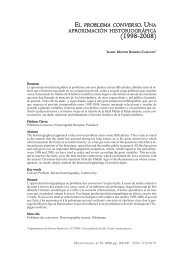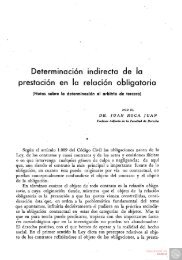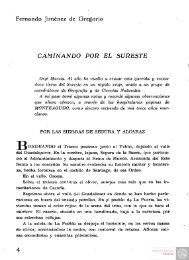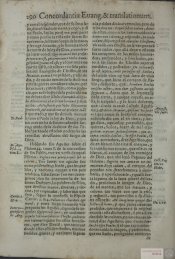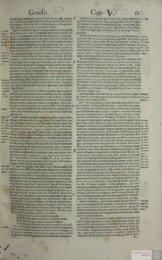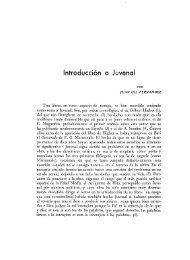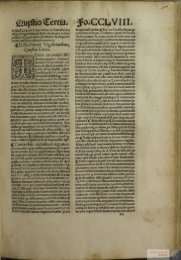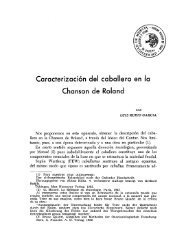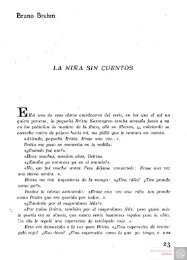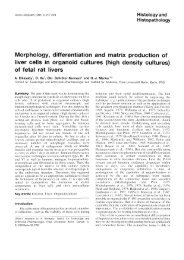A scanning and transmission electron microscopic study of ... - Digitum
A scanning and transmission electron microscopic study of ... - Digitum
A scanning and transmission electron microscopic study of ... - Digitum
You also want an ePaper? Increase the reach of your titles
YUMPU automatically turns print PDFs into web optimized ePapers that Google loves.
Chicken egg membrane<br />
TEM <strong>study</strong>. At lower power TEM, the fibres were<br />
seen to be organized into groups <strong>of</strong> bundles. In each<br />
bundle, the fibres were al1 oriented similarly; frequently,<br />
a bundle <strong>of</strong> fibres sectioned longitudinally or obliquely<br />
alternated with another in which the fibres were<br />
sections transversely (Fig. 20). The short diameter <strong>of</strong><br />
300 fibres ranged from .ll to 4.14 (mean = 1.37 pm;<br />
SD = .76 pm). The larger fibres tended to be located<br />
more superficially (i.e. nearer the shell). The mean<br />
thickness <strong>of</strong> the mantle layer was .39 pm (SD = .20<br />
pm). The diameters <strong>of</strong> the longitudinal channels in the<br />
fibre core ranged from .O8 to 1.11 pn (mean = .27 pm;<br />
SD = .20 pm). The gaps between the fibre core <strong>and</strong> the<br />
mantle layer varied from .O3 to .O7 p.<br />
At the attachment sites <strong>of</strong> the mamillary cores, many<br />
small pr<strong>of</strong>iles measuring about 3 pm in diameter were<br />
present (Fig. 21). These structures probably<br />
corresponded to the globules observed with the SEM<br />
(see above <strong>and</strong> Fig. 18). Fibrillar material was also<br />
observed on the surface <strong>of</strong> <strong>and</strong> in the intervals between<br />
the fibres (Fig. 22).<br />
Discussion<br />
Terminology. Since the inititation <strong>of</strong> light <strong>microscopic</strong><br />
studies until the more recent ultrastructural studies <strong>of</strong><br />
the structure <strong>of</strong> the avian egg, the term "membrane" has<br />
been traditionally used to denote that part <strong>of</strong> the tissue<br />
which separates the albumen from the shell. It should be<br />
stressed, however, that these "membranes" are not true<br />
biological membranes but are merely investments or<br />
layers <strong>of</strong> material laid down as the egg moves down the<br />
isthmus <strong>of</strong> the oviduct.<br />
The limiting membrane. A thin limiting membrane,<br />
which is continuous <strong>and</strong> impervious, separates the egg<br />
membrane from the albumen <strong>of</strong> the avian egg (Simons<br />
<strong>and</strong> Wiertz, 1963; Bellairs <strong>and</strong> Boyde, 1969). Such a<br />
membrane has also been described in the reptilian egg,<br />
for example in the chelonid (Solomon <strong>and</strong> Baird, 1976),<br />
trionyx (Packard <strong>and</strong> Packard, 1979) <strong>and</strong> kinosterid<br />
turtles (Packard et al., 1984a).<br />
Simons <strong>and</strong> Wiertz (1963) estimated the limiting<br />
membrane to be about 2.7 pm thick, but the present<br />
TEM <strong>study</strong> shows that it is much thinner <strong>and</strong><br />
that it is not <strong>of</strong> uniform thickness but varies from<br />
.O9 to .15 pm. The inner surface (Le. the one which<br />
faces the albumen) is smooth but presents many<br />
undulations. The present TEM observations suggest<br />
that these undulations are, in part, produced by the<br />
fibres which run beneath it. No fenestrations have been<br />
observed. This observation has a functional significance<br />
since it has been suggested that the limiting membrane<br />
not only separates the egg membrane from the<br />
extraembryonic membrane but also may provide defense<br />
against bacterial invasion (Tung <strong>and</strong> Richard, 1972;<br />
Tung et al., 1979).<br />
The egg <strong>and</strong> shell membranes. The existence <strong>of</strong> two<br />
major layers <strong>of</strong> membrane in the avian egg has been<br />
known from early light <strong>microscopic</strong> studies. A double<br />
layer <strong>of</strong> membrane, however, has not been observed in<br />
reptilian eggs, for example, the kinosterid (Packard et<br />
al., 1984a,b) <strong>and</strong> chelonid turtles (Packard, 1980) <strong>and</strong><br />
tuatara, an evolutionarily ancient squamatic reptile<br />
(Packard et al., 1982).<br />
Moran <strong>and</strong> Hale (1936) reported that it was possible<br />
to dissect the egg membrane into two layers <strong>and</strong> the<br />
shell membrane into three layers. This was supported by<br />
Simons <strong>and</strong> Wiertz (1936) who reported that the egg<br />
membrane was made up <strong>of</strong> three layers <strong>and</strong> the shell<br />
membrane <strong>of</strong> six layers. But Simkiss (1958) could not<br />
distinguish separate layers in the two membranes in<br />
histological sections. On the basis <strong>of</strong> SEM observations<br />
<strong>of</strong> tear preparation, the present <strong>study</strong> suggests that the<br />
egg membrane may be composed <strong>of</strong> at least two distinct<br />
layers <strong>of</strong> fibres <strong>and</strong> the shell membrane <strong>of</strong> three or more<br />
layers. However, the possibility that the stratification <strong>of</strong><br />
the fibres seen in the SEM <strong>of</strong> tear preparation could<br />
have been artifactual cannot be ruled out. But if the<br />
stratification is not an artifact, then it would suggest that<br />
the laying down <strong>of</strong> fibres is not one continuous process<br />
but interrupted at intervals as the egg spirals down the<br />
isthmus.<br />
Fibres. A great variability in the size <strong>of</strong> the fibres in<br />
both the egg <strong>and</strong> shell membranes has long been known.<br />
The fibres in the shell membrane show greater<br />
variability than those in the egg membrane. In the<br />
present <strong>study</strong>, the smallest fibres are found to be located<br />
nearest the egg albumen (mean = .3 pm; SD = .12 pm)<br />
<strong>and</strong> the largest ones near the shell (mean = 1.37 pm; SD<br />
= .76). The present results concur with those <strong>of</strong> Simons<br />
<strong>and</strong> Wiertz (1963), C<strong>and</strong>lish (1970), Draper et al.<br />
(1972) <strong>and</strong> Wong et al. (1984) <strong>and</strong> confirm that the<br />
early figures reported by Romankewitsch (1932) <strong>and</strong><br />
Moran <strong>and</strong> Hale (1936) were grossly overestimated. It<br />
also supports the idea that the fibres get larger during<br />
the later stages <strong>of</strong> the passage <strong>of</strong> the egg down the<br />
oviduct (Roman<strong>of</strong>f <strong>and</strong> Roman<strong>of</strong>f, 1949; Draper et al.,<br />
1972; Hodges, 1974). In their immun<strong>of</strong>luorescence<br />
<strong>study</strong>, Wong et al. (1984) concluded that the fibres in<br />
the shell membrane contained q pe 1 collagen whereas<br />
those <strong>of</strong> the egg membrane contained Type 5 collagen,<br />
although the characteristic 67 nm b<strong>and</strong>ing have not been<br />
observed under TEM. Stevenson (1980) has also shown<br />
that these fibres could be digested by a bacterial<br />
protease, Pronase P.<br />
Mash<strong>of</strong>f <strong>and</strong> Stolpmann (1961) described each as<br />
being made up <strong>of</strong> a core surrounded by a mantle with<br />
Bellairs <strong>and</strong> Boyde (1969) called the "medulla" <strong>and</strong><br />
"cortex", respectively. These two components <strong>of</strong> the<br />
fibre have been observed in the present <strong>and</strong> other studies<br />
(Simons <strong>and</strong> Wiertz, 1963; C<strong>and</strong>lish, 1970; Draper et<br />
al., 1972). The two components are separated by a gap<br />
which Draper et al. (1972) called "halo". Under high<br />
power TEM in the present <strong>study</strong>, some fuzzy material<br />
bridging the gap between the mantle layer <strong>and</strong> the fibre



